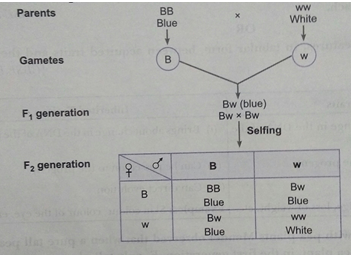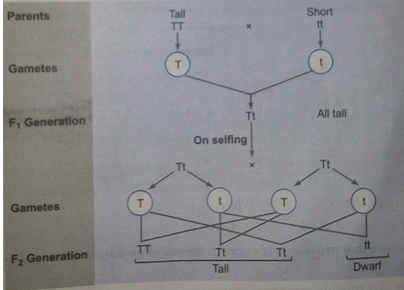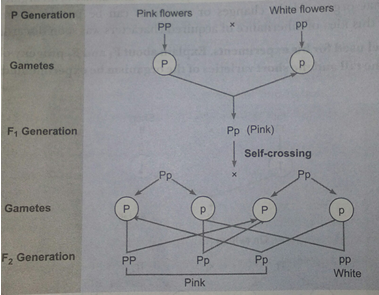Short Answer Questions - II - 3 Marks
Que 1. What is DNA copying? State its importance.
Ans. A process where a DNA molecule produces two similar copies of itself in a reproducing cell is called DNA copying.
Its importance are:
(i) It makes the transmission of characters from parents to the next generation possible.
(ii) It causes variation in the population.
Que 2. ''We cannot pass on to our progeny the experiences and qualifications earned during our life time”. Justify the statement giving reason and examples.
Ans. We acquire knowledge and skill in our lifetime such as learning dance, music, physical fitness, etc. But these skills cannot be passed to our progenies because:
(i) Such characters or experiences acquired during one's lifetime do not bring any change in the DNA of the germ cell.
(ii) Only germ cells are responsible for passing on the characters from the parents to the progeny.
Que 3. "Different species use different strategies to determine sex of a newborn individual. It can be environmental cues or genetically determined'. Explain the statement by giving example for each strategy.
Ans. Environmental cue:
In some animals, the temperature at which fertilised eggs are kept determines whether the developing animal in egg is male or female.
In some animals like snail, individual can change sex.
Genetical cue:
A child who inherits an X chromosome from the father will be a girl and one who inherits a Y chromosome from the father will be a boy.
Que 4. How do variations occur in an offspring?
Ans. Dissimilarities between members of the same species is called variations. Two offsprings of the same parents show certain variations. Variations occur due to sex chromosomes. Variations arising in germplasm (genes) of the organism are heritable. Mother and father contribute to the gene pattern of the offsprings through their chromosomes, in which recombination occurs at the time of gametogenesis. In zygote formation, gene pattern of both parents come together, that causes some Variations between parents and offsprings and amongst offsprings also.
Que 5. Why is variation beneficial to the species but not necessary for the individual?
Ans. The importance of variation in organism introduced during reproduction is that it helps the species of various organisms to survive and flourish even in adverse environment. If all the organisms of a population living in that habitat are exactly identical, then there is a danger that all off them may die and no one would survive under those conditions. This will eliminate the species from the habitat completely. However, if some variations are present in some individual organism to tolerate excessive heat or cold, then there is a chance for survive and flourish even in adverse excessive heat or cold. Thus, variation is useful for the survival of a species over time.
Que 6. What is speciation? List four factors responsible for speciation.
Ans. Speciation is the formation of new species from the pre-existing population.
Factors responsible for speciation:
(i) Genetic drift (ii) Natural selection
(iii) Geographical isolation (iv) Mutation
Que 7. List in tabular form, two distinguishing features between the acquired traits and the inherited traits with one example of each.
OR
List three distinguishing features, in tabular form, between acquired traits and the inherited traits.
Ans.
|
Acquired Traits |
Inherited Traits |
|
(i) Does not bring about change in the DNA of the germ cell. (ii) Cannot be passed on to the progeny. (iii) Cannot direct evolution. Examples: Acquiring knowledge, loss of weight, etc. |
(i) Brings about change in the DNA of the germ cell. (ii) Cannot be passed on to the progeny. (iii) Can direct evolution. Examples: Skin colour, colour of the eye, etc. |
Que 8. In one of his experiments with pea plants mendel observed that when a pure tall pea plant is crossed with a pure dwaft pea plant, in the first generation, F1 only tall plants appear.
(a) What happens to the traits of the dwarf plants in this case?
(b) When the F1 generation plants were self-fertilised, he observed that in the plants of second generation, F2 both all plants and dwarf plants were present. Why it happened? Explain briefly.
Ans. (a) The dwarf traits of the plants is not expressed in the presence of the dominant tall trait. (b) In the F2 generation, both the tall and dwarf traits are present in the ratio of 3: 1. This showed that the traits for tallness and dwarfness are present in the F1 generation, but the dwarfness, being the recessive trait does not express itself in the presence of tallness, the dominant trait.
Que 9. What are chromosomes? Explain how in sexually reproducing organisms the number of chromosomes in the progeny is maintained.
Ans. Chromosomes are thread-like structure, made of protein and DNA, found in the nucleus at the time of cell division.
In sexually reproducing organisms, the gametes undergo meiosis, and hence, each gamete contains only half a set of chromosomes. When two gamete fuse, the zygote formed contains the full set of chromosomes. Hence the formation of gamete by meiosis helps to maintain the number of chromosomes in the progeny.
Que 10. “Two areas of study namely ‘evolution’ and ‘classification’ are interlinked”. Justify this statement.
Ans. Different forms of organisms have organisms have evolution during the course of evolution. Classification deals with grouping of these organisms into groups and subgroups based on their similarities and differences. The more characteristics any two species have in common more closely they are related. In other words, they will have a more recent ancestor.
Thus, classification helps tracing the evolutionary relationships between the two organisms. Hence classification and evolutions are interlinked.
Que 11. A pea plant with blue colour flower denoted by BB is cross-bred with a pea plant with white flower denoted by ww.
(a) What is the expected colour of the flowers in the F1 progeny?
(b) What will be the percentage of plants bearing white flower in F2 generation, when the flowers F1 plants were selfed?
(c) State the expected ratio of the genotype BB and Bw in the F2 progeny.
Ans.

(a) Blue
(b) 25%
(c) BB: Bw = 1: 2
Que 12. Explain the following:
(a) Speciation
(b) Natural selection
Ans. (a) The process by which new species develop from the exiting species is known as speciation. The factors which could lead to speciation are
(i) Geographical isolation of population caused by various types of barriers such as mountain ranges, rivers and seas. This leads to reproductive isolation because of which there is no flow of genes between separated groups of population.
(ii) Genetic drift caused by drastic changes in the frequencies of particular genes by chance alone.
(iii) Variations caused in individuals because of natural selection.
(b) According to Darwin’s theory of natural selection, the individuals who are most suitable and fit are successful in struggle for existence for food, space, mate, etc. Their offsprings are also better developed and adapted to the environment. Whereas one who are less adapted to the environment may die. Thus, nature selects better adapted organisms. This is called natural selection of the well adapted, better developed individuals of species.
Que 13. ‘’Fossils are related to evolution”, Justify this statement. Give the two ways by which age of the fossils can be estimated?
Ans. Preserved traces of living organisms are called fossils.
Two ways of determining age of fossils are:
(i) Relative  fossils closer of the surface are more recent.
fossils closer of the surface are more recent.
(ii) Dating  finding the ratio of different isotopes of the same element.
finding the ratio of different isotopes of the same element.
Que 14. (i) Planaria, insects, octopus and vertebrates all have eyes. Can we group eyes of these animals together to establish a common evolutionary origin? Justify your answer.
(ii) “Birds have evolved from reptiles “. State evidence to prove the statement.
Ans. (i) No, the structure of the eye in each of the organisms is different.
(ii) Fossils of certain dinosaurs and reptiles show imprints of feathers along with their bones but they could not fly presumably, using the feathers for insulation only. Later they evolved and adapted feathers for flight, thus becoming the ancestors of present day birds.
Que 15. Mention three important features of fossils which help in the study of evolution.
Ans. (i) Fossils represent modes of preservation of ancient species.
(b) Fossils help in establishing evolutionary traits among organisms and their ancestors.
(c) Fossils help in establishing the time period in which organisms lived.
Que 16. Explain analogous organs and homologous organs. Identify the analogous and homologous organs amongst the following:
Wings of an insect, wings of a bat, forelimbs of frog, forelimbs of a human.
Ans. Analogous organs are those organs which have different structural designs and origin but perform similar functions.
Homologous organs are those which have the same basic structural design and origin but perform different functions.
Analogous organs: Wings of an insect, wings of a bat.
Homologous organs: Forelimbs of a frog, forelimbs of a human.
Que 17. Describe the contribution of Lamarck.
Ans. The gradual unfolding of organisms from pre-existing organisms through changes since the beginning of life is called evolution. The theory proposed by J.B. Lamarck is known as the theory of inheritance of acquired characters. According to this theory, the use and disuse of an organ leads to acquiring of change in that organ. These changes or variations can be passed on from one generation to the next but this idea of inheritance of acquired characters was soon discarded.
Que 18. Name the organism Mendel used for his experiments. Explain about F1 and F2 progeny obtained by Mendel when he bred the tall and the short varieties of the organism he experimented with.
Ans. Mendel used garden pea.

Que 19. "It is possible that a trait is inherited but may not be expressed." Give a suitable example to justify this statement.
Or
With the help of an example justify the following statement: "A trait may be inherited, but may not be expressed".
Ans. Yes, it is possible that a trait is inherited but may not be expressed.
For example, when pure tall pea plants are crossed with pure dwarf pea plants, only tall pea plants are obtained in F1 generation.
On selfing tall plants of F1, both tall and dwarf plants are obtained in F2 generation in the ratio 3: 1. Reappearance of the dwarf character, a recessive trait in F2 generation shows that the dwarf trait was present in individuals of F1 but it did not express.
Que 20. Name two homologous structures in vertebrates. Why are they so called? How do such organs help in understanding an evolutionary relationship?
Ans. Two homologous structures in vertebrates are:
(i) limbs of birds and reptiles
(ii) limbs of reptiles and amphibians
These are called so because the organs have similar structure to perform different functions in various vertebrates.
Que 21. In a cross between plants with pink flowers and plants with white flowers the offsprings of F1 generation all had pink flowers. When the Fi generation was self-crossed, it was observed in the F2 generation that out of 100, 75 flowers were pink. Make a cross and answer the following:
(a) What are the genotypes of the F1 progeny?
(b) What is the ratio of Pink: White flowers in the F2 generation?
Ans.

Phenotypic ratio Pink : White
3 : 1
Que 22. List three factors that provide evidences in favours of evolution in organisms and state the role of each in brief.
Ans. Three factors that provide evidences are:
(i) Analogous organs-organisms with similar looking organs may have different origin.
(ii) Homologous organs-organisms with apparently different looking organs may have similar origin.
(iii) Fossils-allow us to make estimates of how far back evolutionary relationships go. Fossils when chronologically arranged help in tracing the evolutionary history of an organism.
Que 23. Does geographical isolation of individuals of a species lead to formation of a new species? Provide a suitable explanation.
Ans. Yes, geographical isolation gradually leads to genetic drift. This may impose limitations to sexual reproduction of the separated population. Slowly the separated individuals will reproduce among themselves and generate new variations. Continuous accumulation of those new variations through a few generations may ultimately lead to the formation of a new species.

